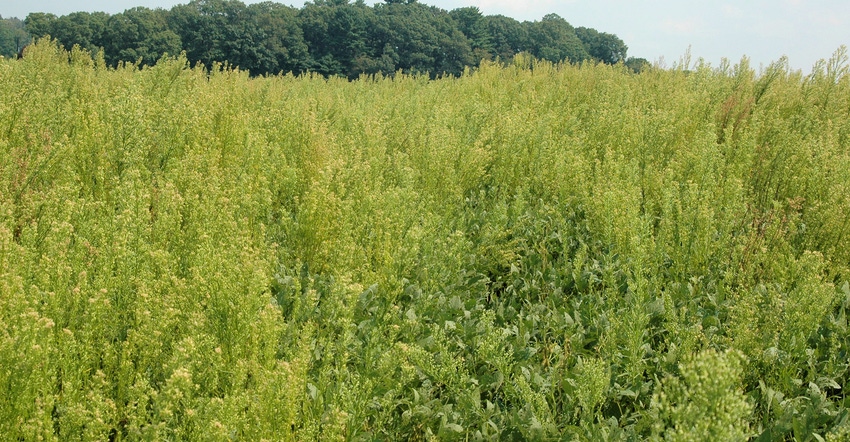October 18, 2021

Dense populations of winter annual weeds can compete with wheat, barley and other small grains in late fall and early spring — and slow the rate of crop development, potentially reducing yield.
If common chickweed, henbit, marestail, winter annual grasses and others are left unchecked, the potential effect on yield could be great. In these situations, it might make sense to kill these weeds in the fall rather than early spring.
Harmony Extra (or generic equivalent) is still one of the most widely used broad-spectrum herbicides for broadleaf weed control. Fall applications have been more consistent than spring applications for weed control in regional trials. However, it has its weaknesses, and other options, or tankmixes, should be considered.
Here are some best bets for common problem weeds:
Common chickweed. Harmony Extra is still effective on it, but there are pockets in Pennsylvania where resistant populations are starting to thrive. Tank-mix with Quelex or Starane Ultra, or include Metricor (metribuzin) in your spray program if ALS-resistant chickweed is prevalent.
Marestail. Products such as 2,4-D, dicamba, Huskie, Quelex and Stinger applied postemergence have activity on this weed.
Speedwell. There are several speedwell species, including corn speedwell, common speedwell, ivy leaf speedwell and others in the area. Depending on the species, their life cycle is either annual or perennial.
Many of the commonly used small-grain herbicides provide little or no control of speedwell. Harmony Extra, plus Quelex, has provided control of ivy leaf speedwell. The same with Harmony Extra, plus Starane Ultra.
PowerFlex has provided control or suppression of certain speedwell species in some university trials. Finesse has a few annual and perennial speedwells listed on its label and usually provides about 80% control of them.
Be cautious of crop rotation intervals if using Finesse. If speedwell is small, Aim provides some control or suppression. Metricor also has activity on speedwell when its small.
Downy brome. Herbicide options include Anthem Flex/Zidua, Finesse, Osprey and PowerFlex.
Annual ryegrass. Anthem Flex/Zidua, Axiom, Axial, Finesse, Osprey, Prowl and PowerFlex have activity on this weed.
Annual bluegrass. Active herbicides include Axiom, Anthem Flex/Zidua, Metricor, Finesse and Osprey.
Roughstalk bluegrass. This is a tall, cool-season perennial that is becoming more of a problem in small grain and forage fields across the state. As it matures, it typically turns reddish-tan and sets seed before summer, goes dormant until fall and remains green during the winter months.
Osprey, PowerFlex and Axial provide control and suppression. Fall and early spring are the best times to apply effective herbicides, but Osprey generally works better in fall.
Don’t apply on cool, cloudy days
Remember that cool (less than 50 degrees F), cloudy days can reduce herbicide activity.
Also, if you plan to frost-seed or drill a companion crop such as red clover in early spring, it might be best to make a fall herbicide application to avoid certain issues with herbicide residuals affecting their establishment. Keep in mind that if products such as PowerFlex, Osprey, Metricor and others are applied in fall, crop restrictions will prevent seeding of certain crops next spring.
Burndown herbicides for no-till small grains include dicamba, Gramoxone, glyphosate, Harmony Extra and Sharpen. Refer to the specific product label for more application information.
The legitimate use of 2,4-D for burndown in wheat and other small grains is uncertain. None of the 2,4-D ester or amine labels specify application just prior to small-grain seeding or emergence.
Some research suggests a minimum delay of seven to 10 days after application at rates up to 1 pint per acre 2,4-D ester. Since 2,4-D burndown in small grains is ambiguous at best, if injury does occur the liability rests with the consultant or the applicator.
Also, for those looking for herbicides that legally can be sprayed in cereal rye, especially for weedy grass control, the choices are limited. There are ongoing herbicide tolerance studies in rye to hopefully find some options for the future.
Here’s a complete list of common fall herbicides for small grains:

Lingenfelter is a weed science Extension associate with Penn State Cooperative Extension.
Source: Penn State Cooperative Extension, which is solely responsible for the information provided and is wholly owned by the source. Informa Business Media and all its subsidiaries are not responsible for any of the content contained in this information asset.
You May Also Like




